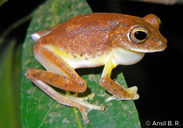|
Mercurana myristicapalustris Abraham, Pyron, Ansil, Zachariah & Zachariah, 2013
Myristica Swamp Treefrog | family: Rhacophoridae subfamily: Rhacophorinae genus: Mercurana |
| Species Description: Abraham RK, Pyron RA, Ansil BR, Zachariah Ar, Zachariah An 2013 Two novel genera and one new species of treefrog (Anura: Rhacophoridae) highlight cryptic diversity in the Western Ghats of India. Zootaxa 3640: 177-189. | |
 © 2013 Ansil B. R. (1 of 2) |
|
|
|
Description Mercurana, which could potentially be confused with Beddomixalus, differs from the latter in the following characters: presence of vomerine teeth and lingual papilla (vs. absence); symphysial knob not sharply pointed (vs. sharply pointed); no stripe on the dorsolateral margin (vs. pale distinct stripe on the dorsolateral margin); canthus rostralis indistinct (vs. rounded); toes 3/4th webbed (vs. half/moderately webbed); finger discs large (vs. moderate); subarticular tubercle on finger IV bifid (vs. rounded); oviposited eggs mixed with mud in shallow pit (vs. eggs openly scattered on ground substrates; Abraham et al 2013). In life, the overall body color of breeding males is rusty-brown speckled with black dots. There are a few yellow blotches on the dorsum and the axillary underside of the arms is white with yellow blotches. The upper-arms and hands are yellowish. The flanks are white with a yellow groin. The upper lip is whitish, as is the ventral surface, the anterior and posterior boarder and ventral surface of the thighs. Hindlimbs are unmarked. There is no vent fold. The iris is silvery-brown with a yellowish tint. When non-breeding, males have a pale yellowish-brown dorsum with black specks. Females have a pale greenish-yellow dorsum and white ventral surface. Distribution and Habitat Country distribution from AmphibiaWeb's database: India
Life History, Abundance, Activity, and Special Behaviors A male and female in amplexus were observed descending to the swamp floor, from the base of a shrub. On reaching the ground, the pair moved into the leaf litter where both individuals slowly changed color, becoming almost inconspicuous on the forest floor. The female was seen digging into the slushy soil and ovipositing into the resulting shallow burrow in the mud, following which she mixed the semiterrestrial eggs with muddy soil. Digging and mixing was aided by employing her well-developed hindlimb webbing. Ensuing oviposition, the pair moved away from the oviposition site (Abraham et al 2013, 2018). The eggs are non-pigmented and early embryonic development occurs in wet mud after pre-monsoon showers. Free-living aquatic tadpoles metamorphose in lowland swamps (Abraham et al 2013). Trends and Threats Possible reasons for amphibian decline General habitat alteration and loss Comments Mercurana myristicapalustris is a recent addition to the family Rhacophoridae and represents an ancient, independent clade, which is sister to the clade containing the Sri Lankan and Indian-Chinese-Indochinese radiations of bushfrogs (Pseudophilautus + Raorchestes; Abraham et al 2013). The genus name is derived from ‘Mercury’ as a tribute to the late Freddie Mercury, the iconic lead singer of the British rock band Queen, whose vibrant music inspired the authors, in combination with Rana (Linnaeus, 1758), a suffix commonly used for many frog taxa (Abraham et al 2013). The specific epithet, a combination of the words ‘Myristica’ for the nutmeg family, and ‘palustris’, which is Latin for swampy, emphasizes the Myristica swamp forest habitat of this frog, which is a fragile and threatened habitat type of the Western Ghats (Abraham et al 2013). This species was featured as News of the Week on December 10, 2018: Described in 2013, Mercurana myristicapalustris is a rare frog species that has a limited range, inhabiting the once-widespread evergreen Myristica swamp forests of the Western Ghats of India. Abraham et al. (2018) report an extensive investigation into the reproductive behavior and larval development. Reproducing during the short pre-monsoon season, this frog displays a mixture of prolonged and explosive breeding, with males using acoustic and physical defenses of calling perches while advertising to females with a complex repertoire. Once in axillary amplexus, the larger-sized female carries the male to a low point in the leaf litter where she digs a shallow burrow in the loamy soil in which to lay eggs. After water accumulates in the nest and surrounding area, motile larvae emerge from the jelly capsule indicating that hypoxia is a trigger for larval emergence. The authors hypothesize that the species is limited to this short window of reproduction because the low oxygen and high acidity of the swamp water requires larval development to be fast and to occur early in the monsoon season. Because the species is highly dependent on Myristica swamp environments, which are critically endangered, they are especially at risk from climate change. (Written by Ann T. Chang)
References
Abraham RK, Mathew JK, Raju DV, Rao R, Zachariah A (2018). ''Reproduction and metamorphosis in the Myristica Swamp tree frog, Mercurana myristicapalustris (Anura: Rhacophoridae).'' PeerJ, 6(e5934). [link] Abraham, R. K., Pyron, R. A., Ansil, B. R., Zachariah, A., Zachariah, A. (2013). ''Two novel genera and one new species of treefrog (Anura: Rhacophoridae) highlight cryptic diversity in the Western Ghats of India.'' Zootaxa, 3640(2), 177-199. Originally submitted by: Robin Kurian Abraham (first posted 2013-05-09) Edited by: Ann T. Chang, Michelle Koo (2018-12-12) Species Account Citation: AmphibiaWeb 2018 Mercurana myristicapalustris: Myristica Swamp Treefrog <https://amphibiaweb.org/species/8003> University of California, Berkeley, CA, USA. Accessed Nov 21, 2024.
Feedback or comments about this page.
Citation: AmphibiaWeb. 2024. <https://amphibiaweb.org> University of California, Berkeley, CA, USA. Accessed 21 Nov 2024. AmphibiaWeb's policy on data use. |



 Map of Life
Map of Life